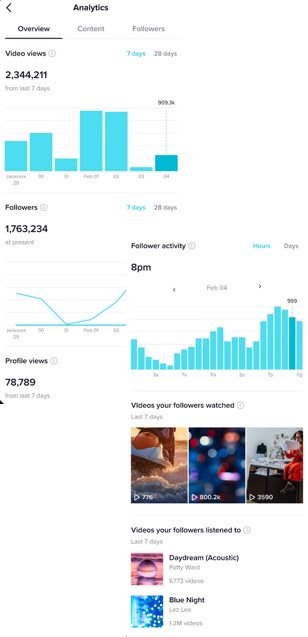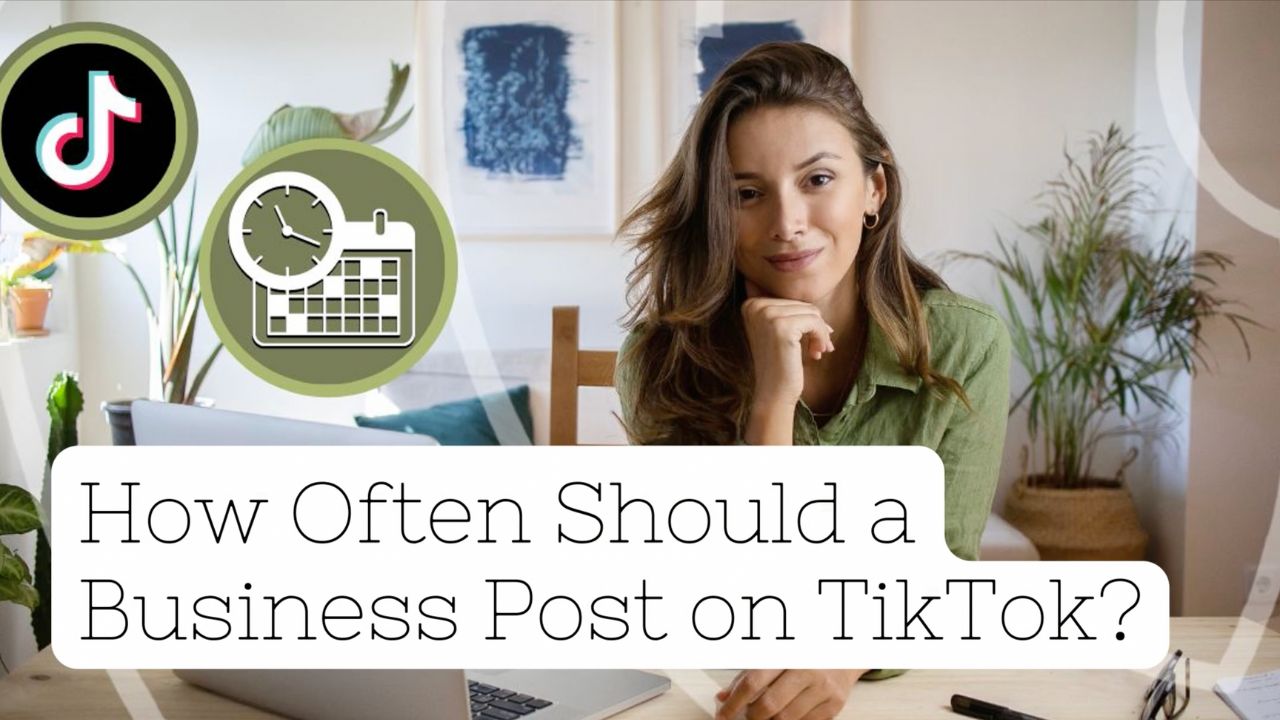TikTok has rapidly risen to become one of the biggest social apps available, with 1.8 billion active users, and likely soon on a par with Instagram.
It attracts an increasing number of businesses looking to connect with their target market.
This post answers a key question such businesses often have...
How often should a business post on TikTok?
After all, each platform is so different!
In this post, we provide the exact info you need to:
- Understand how TikTok’s algorithm works
- What that means for determining the optimal posting frequency for your business.
And finally, we also share the 6 best practices for posting on TikTok to achieve optimal results.
Let's start by digging into their algorithm...
How to Crack TikTok's Algorithm
What do people mean when they talk about TikTok’s “algorithm”?
In brief, it’s the underlying software that determines which users see which videos on the For You feed within the app.
This is different for each and every user based on their own interests and behaviors.
Social media apps aim to engage users for as long as possible. That's how they profit. Their algorithms prioritize content that helps them achieve that.Click To Post OnSo if you’re wondering why you’re seeing a particular video, it’s all down to the algorithm!

What factors are involved? As you’d probably expect, there’s a whole mix including things like:
- Video engagement—such as how long you spend looking at a particular video, whether you like it (by double-tapping or clicking the heart icon) or share it and whether you follow the creator
- Account activity—including what someone’s liked, shared, commented on etc. in the past, the type of device they use, where they’re located, and what their preferences are in their account settings
- Video metadata—this includes things like captions, hashtags, and the music or sound that was used. The algorithm uses all this information to help match videos against a particular user’s preferences.
Remember, TikTok’s primary aim is to keep the user glued to the app for as long as possible, and so will do everything in its power to algorithmically serve them content that’s going to help do that.
To succeed in the app, it’s your job to help them do the same, with content that keeps your target market glued to the screen, while engaging and interacting with your videos.
Watch the following video for a quick summary of how to succeed with organic marketing on TikTok, and then click here for the in-depth guide.
So What Role Does Posting Frequency Play?
Similar to most social apps, consistency is vitally important for succeeding with TikTok's algorithm.
By posting regularly, the algorithm is more likely to start giving your content more reach—in other words, show it to more people.
And the more regularly people see your content, the more they become familiar with you, build a sense of relationship with you and the more likely they are to interact and engage.
But if you go too far, it can have the opposite effect. If you’re posting too often, you may be seen as spammy, your audience may tire of your content, and you can see reach and other KPIs start to drop.
So how often should you be posting on TikTok?
We’ll go into more detail in a sec, but it’s really about keeping an eye on your stats, getting to know your audience and adjusting your strategy accordingly.
- When does your audience tend to be active? Focus on posting more content when they’re likely to be online, and less at other times.
- How much engagement are your videos attracting? If you’re getting a lot, see if you can increase the posting frequency further to capitalize. If you’re not getting much, scale back on frequency if necessary, and focus more on testing out different types of content to try to improve engagement levels.
Stay flexible, and aim for steady, continuous improvements in performance.
A common question on social media platforms is, how often should you be posting? Regardless of platform, posting on a consistent, regular basis is key.Click To Post OnNote this post is one of a series that looks at how often to post on key social media platforms. Check out our other guides too!
How Often Should You Post On TikTok as a Business?
Finding the right posting frequency on TikTok involves trial and error, while keeping a close eye on your analytics and aiming to understand as much about your audience as possible.
As already mentioned, it’s about finding that balance between showing up enough to stay on their radar and build familiarity, while not overloading them to the extent that they start tuning out.
Here’s how to approach it.
1. Get to Know Your Audience
To nail the right posting frequency for your business, you have to get to know your audience inside and out.
This means studying your TikTok analytics. If you’ve not accessed them before, here’s how:
- Head to your profile…
- Tap the three lines in the top right corner…
- Choose the Creator tools option
- Select Analytics

Within Analytics, you’ll find it split into tabs for:
- Overview—for follower growth, video views, profile views, likes, comments and shares. Data is available for up to 60 days.
- Content—look at data for individual posts, such as average watch time, how viewers found your video, total views, shares and so on. Data is only available for the past 7 days, so it’s important to keep checking back in.
- Followers—while the above two sections help indicate engagement levels for your content, the Followers section is where you can dig into who is in your audience, including location and when they’re most active based on the past 7 or 28 days.

2. Test Different Frequencies
There’s no magic one-size-fits-all approach to posting frequency. Instead, it’s about discovering:
- The posting frequency you can reliably sustain over time—remember, posting regularly and consistently is vital to perform well with TikTok’s algorithm
- What works best for your audience and the frequency that appears to give you the best results.
So start with a baseline posting frequency that you can reliably sustain and grow from there. This can be as low as just once a week.
As you figure things out and get the systems in place to crank out more content with the right quality level, experiment with increasing the frequency, while ensuring it remains consistent.
Keep a close eye on how your videos perform at the higher frequency level. If your results increase, test increasing the frequency again, and repeat the cycle.
At some point, you’ll reach a frequency level that’s either impossible to reliably sustain or that fails to deliver a corresponding increase in results or even sees your results decline.
At that point, you know it’s time to scale back to what worked best before, and you’ll have effectively found how often your business should be posting on TikTok (at least, for now!).
3. Monitor Your Engagement
As you’re testing different frequencies, what exactly should you be monitoring to determine what’s working for your audience?
In short, your engagement metrics!
So that means metrics such as your likes, comments, shares and views.
- Are they consistently high? Try ramping up how often you post and see what happens.
- Have they dipped? Or are they on the low side anyway? Try reducing frequency and focus on increasing the quality of your content instead.
4. Adapt and Evolve
What works best right now is unlikely to be what works best forever.
So continue to experiment. As your audience grows, their preferences may shift, and the optimal frequency that worked before may have changed.
So stay agile and adjust your strategy as needed. Keep your analytics under review and fine-tune your approach as needed.
5. Focus on Quality
As already mentioned a few times, quality counts, and it’s worth repeating.
If you’re experimenting with increasing your frequency, don’t sacrifice the quality of your content to do so.
If you're considering increasing your posting frequency on a content platform, don't sacrifice quality to do so. Quality counts, and generally wins out over frequency.Click To Post OnFocus on creating compelling content, with high-quality videos that resonate well with your target audience, keeps them engaged and leaves them wanting more.
Are they likely to be excited about seeing new content from you?
6. Emulate Successful Accounts
As the saying goes, “success doesn’t exist in a vacuum”.
So make a habit of studying the accounts of successful TikTok creators and businesses on the platform, both inside and outside of your industry.
- How frequently are they posting?
- What types of content are they sharing?
Of course, don’t seek to copy their content. But emulate their approach. What are some of the principles that drive their success?
Use their strategies and practices to inspire your own, and adapt what they do to suit your own unique brand and audience.
6 Best Practices for Posting on TikTok
Creating engaging content on TikTok takes time and effort, but the results can be worth it.
Here are some best practices to keep in mind when posting on the platform:
1. Be Creative
TikTok is all about creativity and originality. Experiment with different types of content, from dance challenges to product demonstrations.
The more unique and engaging your content is, the more likely it is to be shared and go viral.
2. Keep It Short
TikTok videos are typically 15 seconds to one minute long.
Keep your content short and to the point to maximize engagement.
3. Use Hashtags
Hashtags can help your videos increase visibility and reach so they get discovered by new viewers.
Use relevant hashtags in your TikTok posts to increase your chances of being seen by a wider audience.
Try using trending TikTok hashtags where relevant.
4. Engage With Your Audience
Respond to comments and messages, and encourage your followers to engage with your content.
Engagement metrics are an important signal to TikTok’s algorithm—the more engagement your videos receive, the more likely they are to be shown to new viewers.
5. Use Analytics
As already detailed, use TikTok's analytics tools to track your video views, engagement, and follower growth.
Pay attention to which types of content perform best and adjust your strategy accordingly.
6. Be Consistent
As with all content platforms, consistency is key to growing an audience, building momentum and increasing your results over time.
Post as often as you’re able to in a consistent way that extracts maximum results for your business from the platform.
Following these best practices and experimenting with different types of content and posting frequencies increase your chances of success on TikTok.
Just remember to play the long game, and not expect overnight success.
If your metrics are increasing over time, particularly follower counts, and you’re creating content of appeal to the target audience for your business, you’re good.
Think about where you’ll be after five years of consistent, regular posting, where you’re growing your audience, constantly improving and mastering the platform.
Frequently Asked Questions
How often should a business post on TikTok?
Posting regularly but not too often is key to staying visible and engaging without overwhelming your audience.
What factors determine TikTok's algorithm for video visibility?
Video engagement, account activity, and video metadata influence how TikTok decides which content to show to users.
How can a business determine the right posting frequency on TikTok?
Experiment with different frequencies, monitor engagement metrics, adapt based on results, focus on quality, and learn from successful accounts.
Why is consistency in posting important for TikTok success?
Consistency helps in staying on your audience's radar, building familiarity, and improving engagement over time on the platform.
What are the best practices for posting on TikTok as a business?
Be creative, keep videos short, use hashtags, engage with your audience, analyze performance, and maintain consistency in posting.
To Conclude
While posting frequency is a vital part of succeeding on TikTok, there’s no one-size-fits-all approach to how often a business should post on the platform.
As we’ve seen, it’s important to find the frequency that best works for you in terms of:
- What you can reliably sustain for long periods of time, while ensuring content quality
- What brings the best results, as indicated by engagement metrics and audience growth.
By following best practices for posting on TikTok, including keeping a close eye on your analytics, you can increase your visibility, attract new followers and ultimately drive new business.










